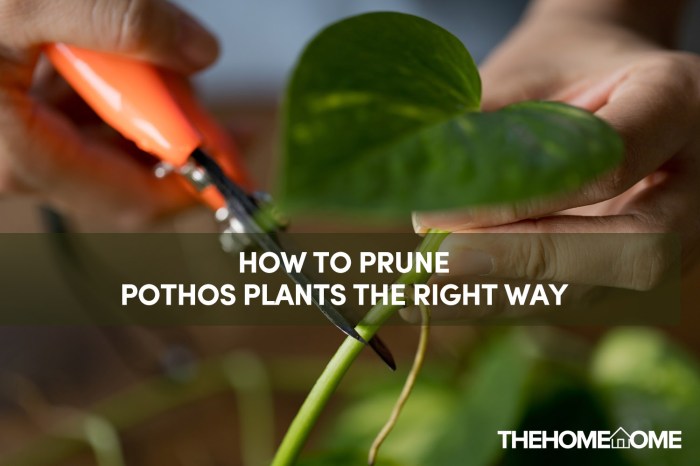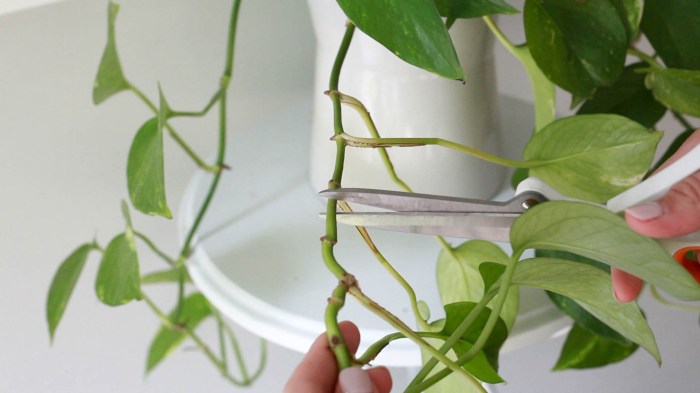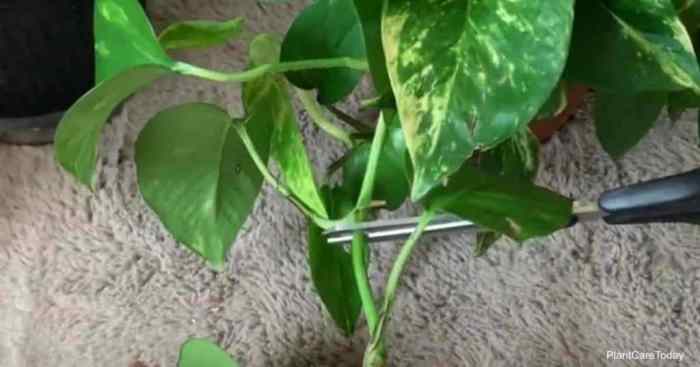How to trim pothos plant – Master the art of trimming your pothos plant with our comprehensive guide. Discover various techniques, identify optimal growth patterns, and learn the benefits of regular trimming. Unleash the full potential of your pothos plant and keep it thriving with our expert tips.
From understanding the different growth stages to troubleshooting common issues, this guide equips you with the knowledge and skills to maintain a healthy and visually appealing pothos plant.
Trimming Techniques: How To Trim Pothos Plant
Trimming pothos plants is crucial for maintaining their health and aesthetic appeal. There are various techniques you can employ to achieve the desired shape and size.
Stem Cutting
Stem cutting involves removing a portion of the stem to propagate new plants or remove unwanted growth. To do this:
- Identify a healthy stem with several nodes (points where leaves grow).
- Use sharp, sterilized shears to cut the stem just below a node.
- Remove the lower leaves from the cutting to expose the nodes.
- Dip the cutting in rooting hormone (optional) and plant it in moist soil or water.
Pruning
Pruning is used to remove dead, diseased, or overgrown stems and leaves. This technique encourages new growth and keeps the plant healthy.
- Identify the affected stems or leaves.
- Use sharp shears to cut them off as close to the main stem as possible.
- Remove any yellowed or damaged leaves.
- Disinfect the shears after pruning to prevent disease spread.
Pinching
Pinching is a gentle technique that involves removing the growing tip of a stem. This encourages the plant to produce multiple stems, resulting in a fuller appearance.
- Identify a healthy stem with an active growing tip.
- Use your thumb and forefinger to gently pinch off the tip, just above a node.
- Repeat the process on other stems as desired.
Identifying Growth Patterns

Understanding the growth patterns of pothos plants is crucial for proper trimming. Different growth patterns necessitate specific trimming techniques to maintain optimal plant health and aesthetics.
Pothos plants exhibit two primary growth patterns: trailing and climbing. Trailing pothos, such as the Golden Pothos, have long, vine-like stems that cascade downward. Climbing pothos, like the Marble Queen, possess aerial roots that enable them to cling to surfaces and grow upwards.
Optimal Trimming Time
The ideal time to trim pothos plants varies based on their growth stage. For trailing pothos, regular trimming is recommended to prevent legginess and encourage bushier growth. Trimming can commence when the stems reach a desired length or appear sparse.
Climbing pothos, on the other hand, require less frequent trimming. Their stems can be allowed to grow longer, providing support for aerial roots and a lush, cascading effect. However, trimming may be necessary to remove damaged or overgrown stems.
Signs of Overgrowth and Undergrowth
Recognizing signs of overgrowth and undergrowth is essential for effective trimming. Overgrown pothos plants may exhibit leggy stems, sparse foliage, and yellowing or wilted leaves. Undergrown plants, on the other hand, may have stunted growth, small leaves, and a lack of vigor.
By observing the plant’s growth patterns and identifying signs of overgrowth or undergrowth, you can determine the appropriate trimming techniques to maintain a healthy and visually appealing pothos plant.
Benefits of Trimming

Trimming pothos plants offers numerous advantages, promoting their overall health and aesthetics. By regularly removing excess growth, you can:
- Encourage Healthy Growth:Trimming stimulates the plant to produce new shoots and leaves, resulting in a fuller, bushier appearance.
- Prevent Legginess:Untrimmed pothos plants tend to become leggy, with long, bare stems. Trimming encourages the growth of lateral branches, creating a more compact and aesthetically pleasing shape.
- Enhance Aesthetics:Trimming removes dead, damaged, or overgrown leaves, improving the overall appearance of the plant. It allows the healthy foliage to take center stage, showcasing its vibrant colors and patterns.
Tools and Equipment
Trimming pothos plants requires a specific set of tools to ensure a clean, precise, and efficient process. Here’s a comprehensive list of essential tools and equipment, along with their descriptions and usage guidelines:
Sharp Scissors
Sharp scissors are indispensable for trimming pothos plants. Opt for scissors with sharp blades that can make clean cuts without crushing or tearing the stems. Ensure the blades are made of stainless steel to prevent rust and ensure durability.
When it comes to trimming pothos plants, it’s important to remove any dead or yellowed leaves. For a more comprehensive guide on trimming plants, you can refer to our article on how to trim liriope plants . Returning to pothos plants, regular trimming encourages new growth and helps maintain a healthy appearance.
Pruning Shears
Pruning shears are designed specifically for trimming woody stems and thicker branches. They provide a more powerful cutting action compared to scissors and are ideal for removing large or overgrown stems. Choose pruning shears with sharp, bypass blades that cut cleanly and minimize damage to the plant.
When trimming pothos plants, it’s important to remove any dead or yellowing leaves and stems. You can also trim back the vines to encourage bushier growth. For more tips on trimming plants, check out our guide on how to trim rosemary plants . After trimming, give your pothos plant plenty of indirect sunlight and water it regularly to keep it healthy and thriving.
Sharp Knife
A sharp knife can be used for precise cuts, especially when removing diseased or damaged leaves or stems. Select a knife with a sharp, pointed blade and a comfortable grip. Always use caution when handling a knife and make sure to keep it away from children and pets.
Gloves, How to trim pothos plant
Wearing gloves is recommended when trimming pothos plants to protect your hands from potential thorns or sap. Choose gloves made of durable material that provides a good grip and allows for dexterity.
Safety Glasses
Safety glasses are essential to protect your eyes from flying debris or plant sap. Always wear safety glasses when using sharp tools or working with plants that may release irritating substances.
To trim pothos plants, start by removing any dead or yellowing leaves. You can also trim the stems back to encourage new growth. When trimming aquarium plants, use sharp, clean shears to avoid damaging the plants. Start by removing any dead or decaying leaves, and then trim the stems back to the desired length.
For more information on how to trim aquarium plants, visit how to trim aquarium plants . After trimming, water your pothos plant thoroughly and place it in a bright, indirect light location.
Troubleshooting Common Issues

Trimming pothos plants can occasionally lead to issues like yellowing leaves or stunted growth. Understanding the causes and implementing preventative measures can help ensure a healthy plant.
Yellowing Leaves
- Overwatering:Excessive watering can suffocate the roots, causing leaves to turn yellow and wilt. Allow the soil to dry out between waterings.
- Nutrient deficiency:Lack of essential nutrients, especially nitrogen, can cause leaves to yellow. Fertilize the plant regularly with a balanced fertilizer.
- Too much light:Prolonged exposure to direct sunlight can scorch the leaves, causing them to turn yellow. Move the plant to a location with indirect light.
Stunted Growth
- Insufficient light:Pothos plants need bright, indirect light to thrive. Inadequate light can stunt their growth.
- Overcrowding:When a pothos plant becomes too dense, it can restrict airflow and limit growth. Regularly prune and repot the plant to provide adequate space.
- Pest infestation:Pests like mealybugs and spider mites can damage the plant, leading to stunted growth. Inspect the plant regularly and treat infestations promptly.
Final Conclusion

Regular trimming is essential for the well-being and beauty of your pothos plant. By following the techniques Artikeld in this guide, you can promote healthy growth, prevent legginess, and enhance the overall appearance of your plant. Embrace the joy of plant care and witness the transformative power of proper trimming.
Expert Answers
How often should I trim my pothos plant?
Trim your pothos plant every 2-3 months during the growing season (spring and summer) to maintain its shape and encourage new growth.
What are the signs of an overgrown pothos plant?
Signs of an overgrown pothos plant include long, leggy stems, sparse foliage, and yellowing leaves.
Can I propagate pothos plants from cuttings?
Yes, you can easily propagate pothos plants by taking stem cuttings and rooting them in water or soil.